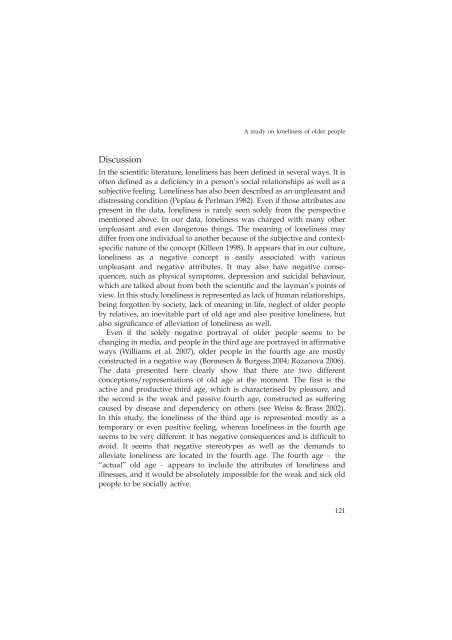Avaa tiedosto - TamPub - Tampereen yliopisto
Avaa tiedosto - TamPub - Tampereen yliopisto
Avaa tiedosto - TamPub - Tampereen yliopisto
You also want an ePaper? Increase the reach of your titles
YUMPU automatically turns print PDFs into web optimized ePapers that Google loves.
A study on loneliness of older people<br />
Discussion<br />
In the scientific literature, loneliness has been defined in several ways. It is<br />
often defined as a deficiency in a person’s social relationships as well as a<br />
subjective feeling. Loneliness has also been described as an unpleasant and<br />
distressing condition (Peplau & Perlman 1982). Even if those attributes are<br />
present in the data, loneliness is rarely seen solely from the perspective<br />
mentioned above. In our data, loneliness was charged with many other<br />
unpleasant and even dangerous things. The meaning of loneliness may<br />
differ from one individual to another because of the subjective and contextspecific<br />
nature of the concept (Killeen 1998). It appears that in our culture,<br />
loneliness as a negative concept is easily associated with various<br />
unpleasant and negative attributes. It may also have negative consequences,<br />
such as physical symptoms, depression and suicidal behaviour,<br />
which are talked about from both the scientific and the layman’s points of<br />
view. In this study loneliness is represented as lack of human relationships,<br />
being forgotten by society, lack of meaning in life, neglect of older people<br />
by relatives, an inevitable part of old age and also positive loneliness, but<br />
also significance of alleviation of loneliness as well.<br />
Even if the solely negative portrayal of older people seems to be<br />
changing in media, and people in the third age are portrayed in affirmative<br />
ways (Williams et al. 2007), older people in the fourth age are mostly<br />
constructed in a negative way (Bonnesen & Burgess 2004; Rozanova 2006).<br />
The data presented here clearly show that there are two different<br />
conceptions/representations of old age at the moment. The first is the<br />
active and productive third age, which is characterised by pleasure, and<br />
the second is the weak and passive fourth age, constructed as suffering<br />
caused by disease and dependency on others (see Weiss & Brass 2002).<br />
In this study, the loneliness of the third age is represented mostly as a<br />
temporary or even positive feeling, whereas loneliness in the fourth age<br />
seems to be very different: it has negative consequences and is difficult to<br />
avoid. It seems that negative stereotypes as well as the demands to<br />
alleviate loneliness are located in the fourth age. The fourth age the<br />
‘‘actual’’ old age appears to include the attributes of loneliness and<br />
illnesses, and it would be absolutely impossible for the weak and sick old<br />
people to be socially active.<br />
121














